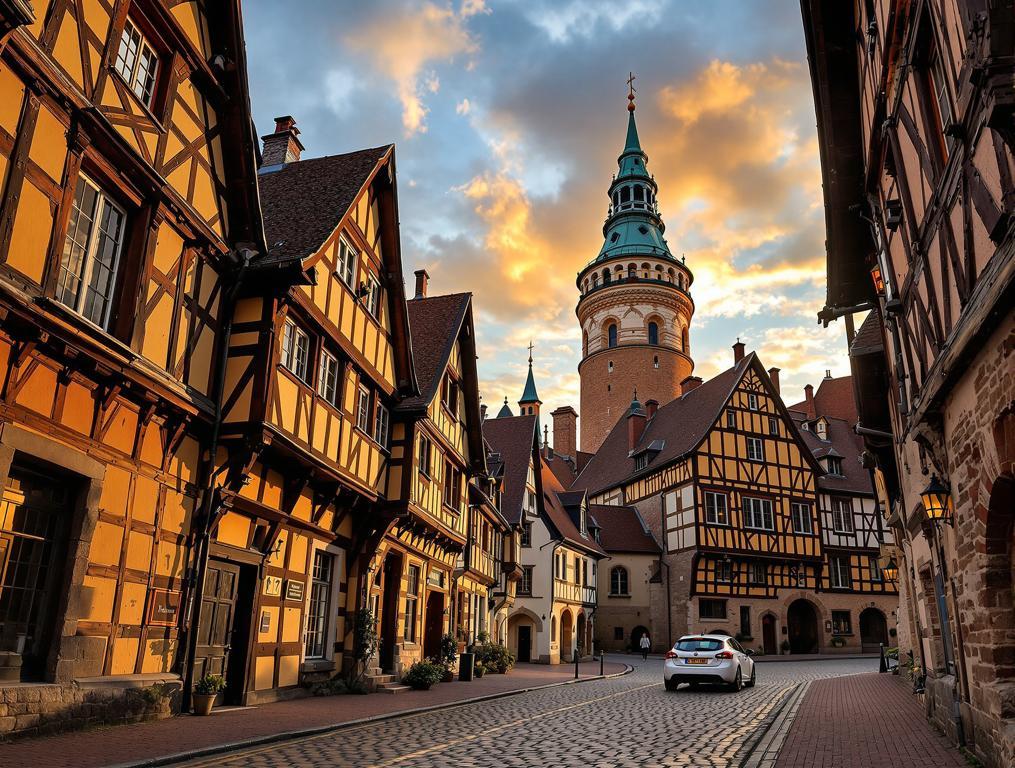The Blue Tower rises against the morning sky as I step into Bad Wimpfen’s cobblestone streets. With just 7,578 residents, this medieval haven along Germany’s Neckar River holds a secret that larger destinations can’t match. While thousands flock to Rothenburg for Instagram-worthy frames, this 13th-century imperial town preserves 755-year-old timber-framed buildings with an authenticity that stopped me in my tracks.
My footsteps echo across the market square as church bells mark 8 AM. Bad Wimpfen sits 15 kilometers north of Heilbronn in Baden-Württemberg, yet somehow exists in its own medieval bubble. Unlike Germany’s famous tourist magnets, the preservation here feels less like a museum and more like a living, breathing community.
A Medieval Haven Where Time Forgot Modern Tourism
Bad Wimpfen packs an astonishing 59 protected historical buildings into just 19.45 square kilometers, creating one of Germany’s densest concentrations of medieval architecture. The entire old town has been meticulously restored since the 1970s, with half-timbered houses dating back to 1266.
Walking down Klostergasse reveals facades where master craftsmen carved their signatures centuries ago. While some German towns recreate medieval aesthetics, these structures survived wars, fires, and modernization waves intact.
What struck me most was the Blue Tower’s legacy. Built in 1170, it served as home to tower-keepers for 650 years until 1820 – a continuous occupation record few European landmarks can claim. I climbed its narrow, worn steps to discover panoramic views across the Neckar Valley.
While some historical destinations embrace technological interpretation, Bad Wimpfen’s appeal lies in its tangible authenticity and preserved medieval atmosphere. Here, history isn’t reimagined – it simply never left.
The Uncrowded Alternative to Germany’s Tourist Hotspots
Bad Wimpfen offers what Rothenburg ob der Tauber lost decades ago: breathing room. Where Rothenburg’s 11,502 residents navigate streets flooded with tour buses, Bad Wimpfen’s smaller population maintains the quiet dignity of a working historical town.
The thermal spa culture adds another dimension absent in purely medieval destinations. Unlike grandiose Baden-Baden with its luxury spas, Bad Wimpfen’s wellness traditions remain refreshingly unpretentious, blending naturally with its historical character.
“We could have gone to Rothenburg like everyone else, but here we actually experience medieval Germany rather than just photographing it. The buildings tell stories without souvenir shops interrupting.”
European travelers seeking authentic medieval experiences can find similar historical depth in places like Pradelles, though Bad Wimpfen’s German Reformation history offers a distinctly different cultural narrative.
The town’s comprehensive preservation efforts since the 1970s mirror successful architectural conservation projects like Eureka Springs, where historical buildings similarly form the cornerstone of cultural identity.
What the Guidebooks Won’t Tell You
Visit on Wednesday mornings for the quietest tower experiences – I had the Blue Tower’s panoramic view entirely to myself at 8:30 AM. The €2 entry fee for the Steinhaus reveals spectacularly preserved medieval wall paintings usually missed by day-trippers.
For the perfect blend of wellness and history, arrive at the thermal baths after 3 PM when the morning crowds disperse. Bad Wimpfen’s spa traditions represent a continental approach to wellness, offering an alternative to destinations like Ischia where volcanic thermal waters attract millions of health-conscious travelers.
Local restaurants incorporate mineral-rich spa water into traditional Swabian dishes – try the Maultaschen at Adler Gasthaus, where these pasta pockets gain subtle mineral notes from the local springs. Locals say “Ich möchle” instead of standard German “Ich möchte” when ordering – try it for immediate smiles.
Summer 2025: The Perfect Time to Discover Bad Wimpfen
With summer 2025’s growing interest in authentic, smaller-scale historic towns and wellness tourism, Bad Wimpfen sits perfectly positioned at this intersection. The Neckar River promenade comes alive with locals enjoying evening walks while medieval timber frames glow in the golden hour light.
As Sarah photographed the morning light hitting centuries-old facades, I watched Emma skip across cobblestones that have witnessed 800 years of footsteps. Like a well-preserved medieval manuscript discovered in a forgotten monastery library, Bad Wimpfen reveals its secrets only to those patient enough to read between the lines of Germany’s more famous destinations.
